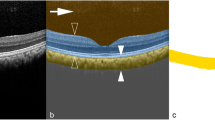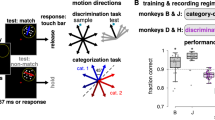Abstract
ETTLINGER1, reviewing the literature on cross-modal matching in primates, concluded that whereas man and chimpanzees seemed to be capable of such matching, the evidence concerning the monkey was ambiguous. Cowey and Weiskrantz2, however, reported a method which resulted in a successful demonstration of a tactile–visual cross-modal match in normal rhesus monkeys. Their success seemed to result from the use of stimulus shapes made from powdered monkey diet, which the animal could eat. Such a training paradigm would be more natural—and therefore presumably easier—for the animal to master. In their experiment, monkeys were allowed to sample ten palatable and ten different unpalatable shapes (treated with quinine) in the dark; subsequently, the monkeys were given a choice between one palatable and one unpalatable shape, presented with the house light switched on. The monkeys chose the palatable shape significantly more often than the unpalatable, showing that a cross-modal match had occurred.
This is a preview of subscription content, access via your institution
Access options
Subscribe to this journal
Receive 51 print issues and online access
$199.00 per year
only $3.90 per issue
Buy this article
- Purchase on SpringerLink
- Instant access to full article PDF
Prices may be subject to local taxes which are calculated during checkout
Similar content being viewed by others
References
Ettlinger, G., in Memory and Transfer of Information (edit. by Zippel, H. P.), (Plenum, New York, 1973).
Cowey, A., and Weiskrantz, L., Neuropsychologia, 13, 117–120 (1975).
Zeki, S. M., Brain Res., 34, 19–25 (1971).
Kullback, S., Information Theory and Statistics, second ed., 399 (Dover, New York, 1968).
Iwai, E., and Mishkin, M., in Neurophysiological Basis of Learning and Behaviour (edit. by Yoshii, N., and Buchwald, N. A.), (Osaka University Press, 1968).
Iversen, S. D., Brain Res., 19, 277–289 (1970).
Gross, C. G., in Handbook of Sensory Physiology (edit. by Jung, R.), 7 Part 3 (Springer, Berlin, 1972).
Jones, E. G., and Powell, T. P. S., Brain, 93, 793–820 (1970).
Pandya, D. N., and Kuypers, H. G. J. H., Brain Res., 13, 13–36 (1969).
Author information
Authors and Affiliations
Rights and permissions
About this article
Cite this article
SAHGAL, A., PETRIDES, M. & IVERSEN, S. Cross-modal matching in the monkey after discrete temporal lobe lesions. Nature 257, 672–674 (1975). https://doi.org/10.1038/257672a0
Received:
Accepted:
Issue date:
DOI: https://doi.org/10.1038/257672a0



